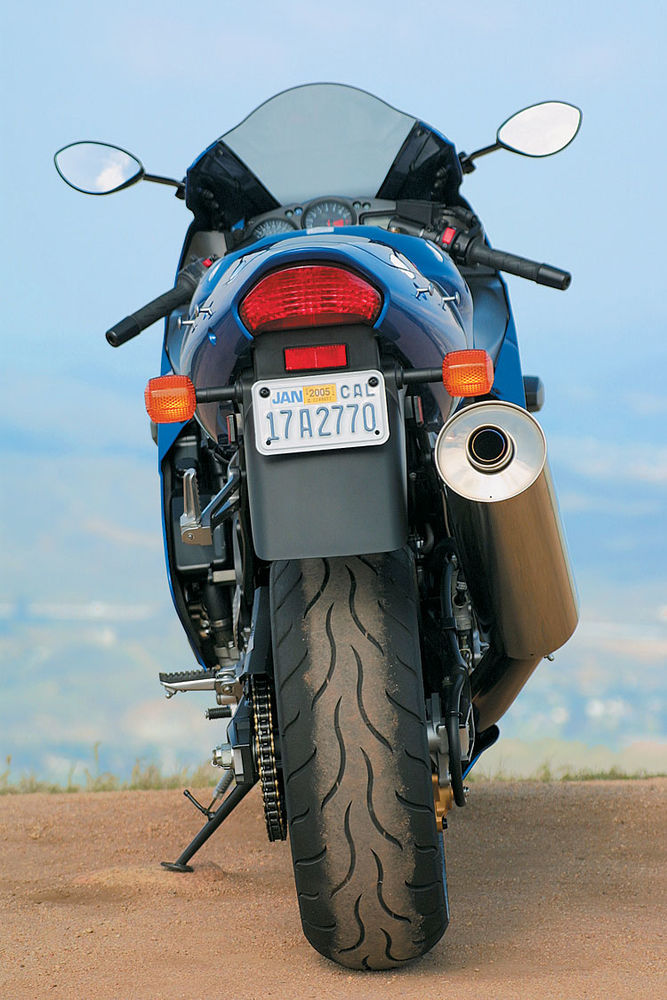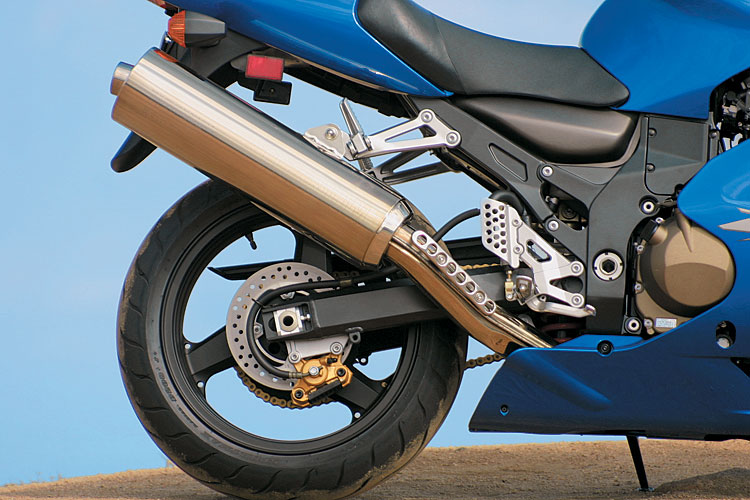Kawasaki Ninja ZX-12R vs. Suzuki Hayabusa GSX1300R

I felt an adrenaline rush simply from reading Christian's e-mail message, "Eric, could you do a test ride for us as soon as you return from Thailand? Hayabusa vs. ZX-12R. Please let me know." Talk about an offer I couldn't refuse!
In my excitement to reply, I permanently crushed the Y-E-S-! buttons on a friend's keyboard and drooled on the rest of them. While logistical issues dictated conducting the tests consecutively rather than simultaneously, that only meant I got to spend twice as much seat time on each bike. What a tragedy!
When it comes to raw speed and power, the ZX-12R and GSX1300R will scorch the paint off of anything outside of the Brickyard or the Bonneville Salt Flats. But let me back that hunk of hyperbole up with a few facts to put things in context. With top speeds in the vicinity of 185+ mph, these two-wheeled torpedoes could race from L.A. to New York in a little under 18 hours. If skydivers fell horizontally, their relatively puny terminal velocity of 135 mph would leave them cartwheeling in the wake of these twin missiles.
Engine and Transmission
I put these bikes through a veritable touring decathlon that ranged hundreds of miles apiece, encompassing straight-shot highway, moderate sweepers, canyon switchbacks, and of course, the occasional long flat stretch of deserted tarmac for - well, you know what for. Neither bike missed a shift, even swapping gears seamlessly at high revs, but the Kawi's tranny proved reticent to permit neutral on many occasions. Once moving freely, the bottomless well of acceleration on demand made passing and tactical maneuvers happen almost before I thought of them. Granted, most folks aren't going to make a habit of winding these bikes out to the end of sixth gear, but the anywhere, anytime, in any gear, with any amount of ballast, instant acceleration dispensed with silky smooth control is a very real-world benefit of their giant mills.

These beasts run 6-speed Ram Air, inducted 16-valve, DOHC, inline-fours that alternately purr like kittens or roar like infuriated lions, depending on your rpm. The Kawi's 1199cc mill gives up 100cc to the Suzi, with reliable reports putting the ZX-12R's output in the vicinity of 152 bhp and 71 ft-lbs of torque and the Busa at 148 bhp and 91 ft-lbs. That data may be pertinent if your idea of a weekend jaunt involves a Christmas tree and burnout pit, but needless to say, these differences disappear in even the most extreme of street use conditions. Simply put, both bikes accelerate hard enough to make your earlobes touch.
Forced to make a choice, I have to give this category to the Busa, based solely on its transmission's superior ability to find neutral and the higher torque figure. A razor-thin distinction to be sure.
Chassis and Brakes
In slow traffic, both bikes proved narrow enough to split lanes effectively, and the throttle, brake, and steering responses at slow speeds were less abrupt than those of many of their litre-bike brethren. The ZX-12R sports an aluminum monocoque frame, while the Busa has a twin spar with a 1.4 inch longer wheelbase. Each proffers similarly steep steering head angles that readily tip the big bikes into turns. The Kawi's UNI-TRAK rear suspension employs a stepless compression and rebound damping adjuster, and the linkage system responds to compression by proportionally increasing the damping and spring rate. The Suzi also runs a link-type system with a fully adjustable shock cushioning a bridged aluminum swingarm. Both front suspensions are managed by a pair of 43mm inverted cartridge forks, which are also adjustable for preload, compression, and rebound damping. The result: two readily tunable bikes that relish the opportunity to stampede through a carousel sweeper.

Clearly, the twisties aren't the strong suit of these bruisers although they acquit themselves surprisingly well under smooth inputs through a well-planned line. Sloppiness, however, will be punished with the chore-work of tugging a beefy hypertourer carrying a lot of kinetic energy back into shape. Tipping the scales at 463 lbs (ZX-12R) and 478 lbs (Busa) of dry weight, they're roughly 100 lbs heavier than a typical litre-bike. You can really feel this on the brakes, especially in downhill sections.
The bikes wear Tokicos and run dual 320mm discs in front. The Kawi is governed by radial-mounted, opposed, four-piston calipers pinching both the 230mm rear disc as well as the front pair. The Busa's setup consists of 6-piston calipers to the fore and a 240mm dual-piston rear disc aft. Identically configured with 17-inch wheels and 120/70 tires up front, the Busa drives on a Bridgestone Battlax 190/50 rear, while the ZX-12R spins a plump 200/50 Dunlop. Those beefy contact patches made getting on the gas out of turns a huge thrill. Unfortunately, my throttle-happy wrist often left my fingers with a lot of bike to stop approaching the next bend. (Hence, in managing surplus speed heading into the corners, I found myself doing a lot of trail braking.) The Busa's pinchers didn't quite have the bite of the ZX-12R, and required more of a fist to get rapid results. I can attest that once engaged, both systems try hard and have very good feel. Even leaned over at slow speeds, I was able to administer the anchors with precision.
While handling was just about even, I have to give the Kawi the nod for its brakes and slightly more nimble disposition.
Accessories and Arrangements
The Hayabusa's distinctive fairing is art to some, an eyesore to others, but its form is dictated by the function of achieving the lowest coefficient of drag in its class, a crucial factor for achieving top speeds. Meanwhile, the Kawasaki's unassuming appearance attempts to downplay its status as an asphalt-shredding hypertourer, as opposed to the Suzuki's "Look at me!" paint scheme and dramatic aero-hump. Dressed in metallic spark black with a bare minimum of graphics, the ZX-12R's Johnny Cash approach to style stands in stark contrast to the Busa, whose garish comic-book scheme attracts enough stares to satisfy even Brittany Spears' appetite for attention. That said, the new GSX1300RZ designation does offer a far more understated gunmetal-grey edition for those disinclined to choose wild graphics.

Ergonomically, the Busa's platform offers more generous concessions to comfort with its wide, plush seat, while the ZX-12R appears purpose-built for sport-bike performance with a flat firm seat, high peg location, and narrow bars. Surprisingly though, Kawasaki got the resultant symmetry just right for my 5'9" stocky physique and I remained pain free throughout a dawn to well-past dusk day of riding. Both windscreens created a very effective air bubble at my height, behind which I was able to snuggle into a tuck, lean semi-upright with weight distributed evenly in my arms and hips, or stiffen my arms into a completely upright position. I was able to easily log hundreds of miles a day on either bike without ill effect.
If you ride with a co-pilot, it's important to note that the Kawi merely offers a small pillion, while the Busa provides a very large and fully functional passenger pad and grab rail. Coupled with a half gallon larger gas tank, and an index finger accessible passing switch to conveniently flick the hi and lo beams, it was easy to declare the Suzi the victor in this category.
Conclusion
Nothing truly prepares you for the bat out of hell that awaits the fighter pilot brave enough to captain these F16s with handlebars. More impressive still, under most conditions, the big brutes deliver their power with the effortless grace and flawless control of an Olympic athlete. While perhaps not the best choice for savage canyon carving or cross-country pack-mule trips, I would heartily recommend either of these hypertourers to anyone who craves heaping gobs of power tempered by disciplined handling and unexpected high-mileage comfort. In the final analysis, I had the Busa ahead by a nose. But with very similar performance-oriented characteristics and nearly identical MSRPs, it's most likely that styling will be the decisive factor separating these bikes in the eye of the prospective beholder.
Technical Specs
Kawasaki ZX12R Ninja®
+ wicked fast, nimble handling
- minimal appointments
Distributor Kawasaki Motors Company, USA
Engine four-stroke inline fourDOHC, 16-valve
Displacement 1,198cc
Bore x Stroke 83 x 55.4mm
Carburetion fuel injection
Power n/a
Cooling liquid
Ignition digital
Transmission six-speed
Frame aluminum monocoque
Front Suspension 43mm inverted forkfully adjustable, 4.7in travel
Rear Suspension UNI-TRAK®fully adjustable, 5.5in travel
Rake/Trail 23.5° / 3.9in (99mm)
Brakes front/rear twin four piston calipers 320mm discs/single fourpiston, 230mm disc
Tires front/rear 120/70 x 17 / 200/50 x17
Dry Weight 463lb (210kg)
Wheelbase 57.1in (1450mm)
Seat height 32.3in (820mm)
Fuel Copacity 5gal (19l)
Fuel Consumption n/a
Colors metallic spark black
MSRP $ 11,299
Suzuki GSX1300R Hayabusa
+ built for hyper-speed, functional appointments
- soft feeling brakes
Distributor American Suzuki Motor Corporation
Engine four-stroke inline fourDOHC, 16-valve
Displacement 1,299cc
Bore x Stroke 81 x 63mm
Carburetion fuel injection
Power n/a
Cooling liquid
Ignition digital/transistorized
Transmission six-speed
Frame twin-spar aluminum
Front Suspension 43mm inverted forkfully adjustable, 4.7in travel
Rear Suspension link typefully adjustable, 5.5in travel
Rake/Trail 24° / 3.8in (97mm)
Brakes front/rear twin six piston calipers 320mm discs /single twin piston, 240mm disc
Tires front/rear 120/70ZR x 17 / 190/50ZR x17
Dry Weight 478lb (217kg)
Wheelbase 58.5in (1485mm)
Seat height 31.7in (805mm)
Fuel Copacity 5.5 gal (21l)
Fuel Consumption n/a
Colors blue/silver, red/black, gray/black
MSRP $ 10,999












